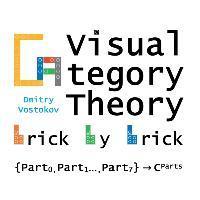Visual Category Theory Brick by Brick: Diagrammatic LEGO(R) Reference

Visual Category Theory Brick by Brick: Diagrammatic LEGO(R) Reference
Part 0 covers universe and sets, set-builder notation, set membership, set inclusion, subsets as members, membership vs. subset, powerset, relations, functions, domain, codomain, range, injection, surjection, bijection, product, union, intersection, set difference, symmetric set difference, sets of functions, function composition, inverse functions.
Part 1 covers the definition of categories, arrows, the composition and associativity of arrows, retracts, equivalence, covariant and contravariant functors, natural transformations, and 2-categories.
Part 2 covers duality, products, coproducts, biproducts, initial and terminal objects, pointed categories, matrix representation of morphisms, and monoids.
Part 3 covers adjoint functors, diagram shapes and categories, cones and cocones, limits and colimits, pullbacks and pushouts.
Part 4 covers non-concrete categories, group objects, monoid, group, opposite, arrow, slice, and coslice categories, forgetful functors, monomorphisms, epimorphisms, and isomorphisms.
Part 5 covers exponentials and evaluation in sets and categories, subobjects, equalizers, equivalence classes and quotients, coequalizers, congruence categories, morphism functors, and presheaves.
Part 6 covers ideas that require a leap of abstraction: vertical and whisker compositions of natural transformations, identity and isomorphism of functors, equivalence, isomorphism, and adjoint equivalence of categories, functor and morphism categories, natural transformations as functors, representable functors, category of presheaves, Yoneda embedding and lemma. It also includes an index for parts 1 - 6.
Part 7 covers ideas related to functional programming: exponentials, disjoint unions, endofunctors and natural transformations, partial and total functions, monads.
PRP: 496.00 Lei
Acesta este Pretul Recomandat de Producator. Pretul de vanzare al produsului este afisat mai jos.
446.40Lei
446.40Lei
496.00 LeiLivrare in 2-4 saptamani
Descrierea produsului
Part 0 covers universe and sets, set-builder notation, set membership, set inclusion, subsets as members, membership vs. subset, powerset, relations, functions, domain, codomain, range, injection, surjection, bijection, product, union, intersection, set difference, symmetric set difference, sets of functions, function composition, inverse functions.
Part 1 covers the definition of categories, arrows, the composition and associativity of arrows, retracts, equivalence, covariant and contravariant functors, natural transformations, and 2-categories.
Part 2 covers duality, products, coproducts, biproducts, initial and terminal objects, pointed categories, matrix representation of morphisms, and monoids.
Part 3 covers adjoint functors, diagram shapes and categories, cones and cocones, limits and colimits, pullbacks and pushouts.
Part 4 covers non-concrete categories, group objects, monoid, group, opposite, arrow, slice, and coslice categories, forgetful functors, monomorphisms, epimorphisms, and isomorphisms.
Part 5 covers exponentials and evaluation in sets and categories, subobjects, equalizers, equivalence classes and quotients, coequalizers, congruence categories, morphism functors, and presheaves.
Part 6 covers ideas that require a leap of abstraction: vertical and whisker compositions of natural transformations, identity and isomorphism of functors, equivalence, isomorphism, and adjoint equivalence of categories, functor and morphism categories, natural transformations as functors, representable functors, category of presheaves, Yoneda embedding and lemma. It also includes an index for parts 1 - 6.
Part 7 covers ideas related to functional programming: exponentials, disjoint unions, endofunctors and natural transformations, partial and total functions, monads.
Detaliile produsului








